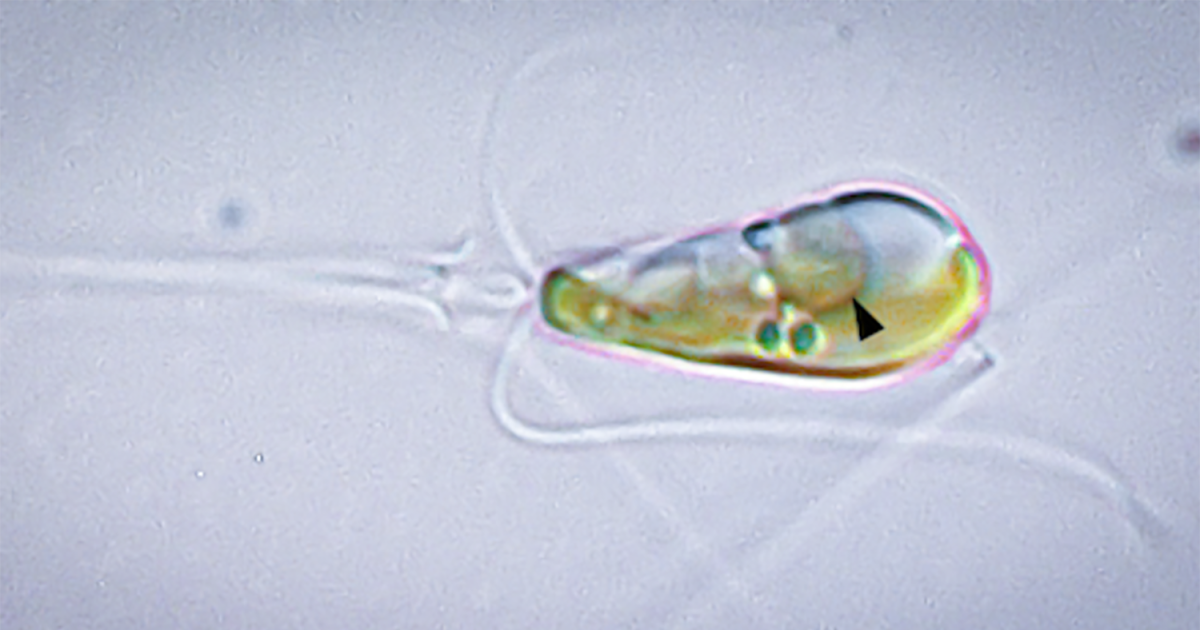From the article:
Scientists have caught a once-in-a-billion-years evolutionary event in progress, as two lifeforms have merged into one organism that boasts abilities its peers would envy. Last time this happened (1.6 billion years ago), certain advanced cells absorbed a type of bacteria that could harvest energy from sunlight. These became organelles called chloroplasts, which gave sunlight-harvesting abilities, as well as a fetching green color, to a group of lifeforms you might have heard of – plants.
And now, scientists have discovered that it’s happening again. A species of algae called Braarudosphaera bigelowii was found to have engulfed a cyanobacterium that lets them do something that algae, and plants in general, can’t normally do – “fixing” nitrogen straight from the air, and combining it with other elements to create more useful compounds.
Born too late to explore the world. Born too soon to explore the stars. Born just in time for Algae 2.0 to drop.
And what a feature drop it was. Right? Or was it? Not sure what “fixing” nitrogen is helpful for…
As any farmer or gardener will tell you, nitrogen is critical for plant growth, and for most plants it’s obtained via the soil. Soil nitrogen can be depleted if not replenished (in an agricultural context, by compost or fertilizer), but there’s plentiful nitrogen in the atmosphere (which is mostly nitrogen, actually) so any plant that has nitrogen fixing abilities has constant access to this critical nutrient. There currently exist nitrogen-fixing plants (peas and clover for example), but they don’t actually do it on their own, they rely on a symbiotic relationship with bacteria.
Ooh could this make for a truly green way to capture carbon and make fertilizer? It would be sweet to have a closed system that grows the algea with solar then you collect it squeze the water out, bury it then start again
Soo, it’s not something that doesn’t happen now and then?
No, the symbiotic relationship means that the bacteria live in/on the plant, much like we have a gut biome of organisms that are discrete from us, but have symbiosis with us.
The article is about a bacterium becoming engulfed within an algal cell and slowly becoming an organelle of that cell.
This process begins as a type of symbiosis, but at the end of it you would no longer call it symbiotic, as it ends as a single organism.
The breathless yammering about “the last time this happened we got plants” seems a little much though. The last time this happened that we know of was 1.5 billion years ago and we got plants. The fact we’ve caught it in the act right now sounds like this might just be a much more common phenomenon than we thought.
The article says
In the 4-billion-odd-year history of life on Earth, primary endosymbiosis is thought to have only happened twice that we know of, and each time was a massive breakthrough for evolution.
It’s possible the only reason we’re aware of these events is because they were massive breakthroughs. After watching it happen, we may have more information about how to spot other times it has happened.
No plants are actually able to break down nitrogen gas. The bacteria that can break it down live in their root systems, not in the plant cells. The root systems are an ecosystem for the bacteria, much loke yoir moith and intestines are for useful bacteria. What this study describes is an algae cell incorporating a nitrogen fixing bacteria into it’s cellular structure, which as far as we can tell has only happened twice in the history of life on earth: when a large bacteria incorporated a smaller one, thus creating eularyotic cells with mitochondria (which was our last common ancestor with plants) and when another eularyotic cell absorbed a photosynthetic bacteria, creating plant chloroplasts.
This is interesting, thank you. So… I’m guessing we don’t really want wild plants to gain this ability? We really want to control this ability? What would happen if all plants gained this ability – would we have any nitrogen left in the atmosphere? I’m guessing we personally (as a species) need the current mixture of air compounds to be a certain way (the way it is now, pretty much) in order not to be poisoned? I’ve heard about oxygen poisoning – that’s a thing, right?
Or we might want to have some plants gain this ability in order to do terraforming of another planet which has mainly nitrogen in its atmosphere, very far into the future? Would be cool. Maybe.
The N2 in the atmosphere go through a lot of conversions in the bacteria and plant but eventually ends up as nitrates which then break down and release N2 back in the atmosphere.
So no we won’t end up with no nitrogen in the atmosphere. Generally we want more nitrogen fixed as most crops deplete the nitrogen and only crops that host the nitrogen fixing bacteria can replenish the fixed nitrogen in the soil.
This is the main reason for crop rotations. Farmers grow corn that depletes the fixed nitrogen and then soy that has bacteria that replenishes it.
It would be great if corn got that feature as a lot of fossil fuels are used to fix nitrogen for fertilizers. See the Haber process for more info. https://en.m.wikipedia.org/wiki/Haber_process
It would be great if corn got that feature
There’s a variety of maize that does fix nitrogen:
https://www.theatlantic.com/science/archive/2018/08/amaizeballs/567140/
There are some political and technical hurdles to adapting it more broadly to the agricultural industry.
Fun fact, one half of the invention of the Haber Bosch process Fritz Haber also invented chemical warfare.
He’s partially responsible for saving perhaps billions of lives through the Haber Bosch process and killing millions through the use and proliferation of chemical weapons.
So long as he’s net positive, eh…? 🥹
Thank you for sharing all this insight! Cheers!
Oh wow, didn’t even think about that. It’d be like the great oxygen event which almost killed all life in earth https://en.m.wikipedia.org/wiki/Great_Oxidation_Event
Nitrogen is crucial for duplicating DNA, which needs to happen for vells to divide. Despite being over 70% of the atmosphere, nitrogen gas is incredibly inert, so most organisms cant use it for any metabolic purposes. There are many bacteria that are able to break down nitrogen gas into useable nitrates, most famously those that live in the root systems of legimes like soy and peanuts, which is why American corn farmers grow so much soy.
Inb4 Kelpians…
Or Kerbals
To the Mun!
Fertiliser is one option.
The ocean is only marginally explored.
Make the most of it I guess?
Man, it’s easier, and way cheaper, to explore the world today than it ever has been before.
I think explore is meant as discover anew, not just travel to a place.
I think even at the height of “exploration” there were already people living in the “explored” places.
Antarctica?
The guvment doesn’t want you to know
If they saw this happen, then it happens far more often than once in a billion years.
The article says it’s been in-progress for the last 100 million years, so “once in a billion years” is really like a 1:10 chance. Gotta get those clicks though.
That’s fair. I expect there are quite a few examples of this happening in various places we are yet to discover.
Some thrive, some die out, but it seems to be a normal evolution of life.
Very interested to see where this goes over the next several thousands of years.
Very interested to see where this goes over the next several hundreds of thousands of years.
Ftfy
So the last time was chloroplasts, right? And that worked out super well for all the other organisms and didn’t do anything catastrophic to the atmosphere, right?
Meh, what bad thing could possibly happen if our nitrogen concentration goes down dramatically? I mean that stuff is basically useless /s
man i can’t wait until 20 years from now when scientists find out that this is actually like, really fucking common or some dumb bullshit like that.
Or at least i hope that happens, because it would be very funny.
Its probably very common. I would suspect its happened before and the larger barrier is unicellular to multicellular life.
i’m guessing the generic is very common, but the specific event here is very rare. Like a unix time party for instance.
A similar thing happens with cockroaches where crucial bacteria are absorbed into cells to ensure inheritance in offspring.
explain please
Bacteria 🦠 goes👋 and then brrrr 👉👌👏👏 in cockroach kids 🪳 so they become 1️⃣, hallelujah 🙏
explain this but without the emojis?
words spoken by someone who has spent 30 years studying the reproductive cycle of the cockroach
So what do we get this time? I hope it’s some uncontrollable monster that eats plastic and religious zealots.
Breathing and using nitrogen directly. I guess that would give some kind of plant that needs less or no soil.
They gonna use this to make corn
Legumes fix nitrogen from the air and still need soil.
Sounds like the creature that was destroying all plants in Interstellar.
Go pitch it to Netflix
Better keep Captain Janeway away from it. She’ll un-tuvix them so fast it’ll make your head spin
You commit one murder and no one let’s you live it down, meanwhile The Sisko renders a planet uninhabitable to humans and tricks a foreign government into joining your war and no one bats an eye.
This isn’t that uncommon, it’s just really hard for it to survive into reproduction. Protists are notorious for it, this one alone has at least three separate bacterial symbiotes and even replaced it’s own mitochondria(which themselves are endosymbiotic bacteria) with another bacteria, essentially reinventing the fucking wheel: https://en.m.wikipedia.org/wiki/Mixotricha_paradoxa
When mitochondria is the powerhouse of the cell actually happens IRL again
As a layman, my interpretation is that scientists have observed a mutation in some prehistoric cells / creatures that is likely positive. In this case an algae and a bacteria somehow combined in such a way that they have become something new and better.
As an optimistic guesser it seems like this probably happens fairly often and is either unlikely to survive or replicate for long. But, having observed something that we have known about is further evidence that we understand ongoing evolution and may have a better, more sound understanding of how life came to be.
I guess that’s probably interesting because it helps us better understand what the building blocks for life are, and as we discover them on other planets or in other places in outer space we may better be equipped to understand how or if life exists outside our own world.
I think this means Ents will become a thing now.
Can it eat plastic waste?
No
What about fusion? Can it cause fusion?
They don’t have arms and legs to do the dance with.
deleted by creator








